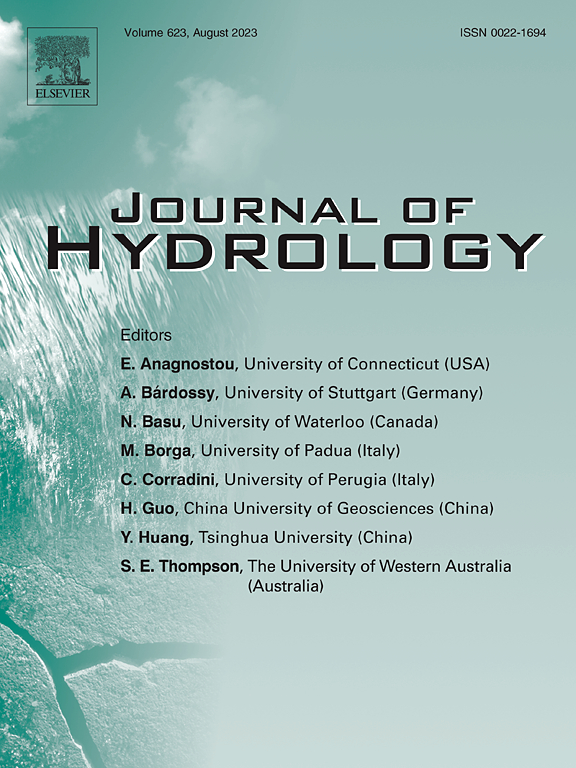雨雪洪水的趋势和因果结构
IF 5.9
1区 地球科学
Q1 ENGINEERING, CIVIL
引用次数: 0
摘要
近年来,由于其破坏性影响,雨雪事件受到越来越多的关注。ROS事件的特征是雨水落在已有的积雪上,这带来了相当大的洪水风险。在这项研究中,我们提出了一种新的方法,通过同时建立降雨、雪水当量、气温和露点温度的阈值来定义具有潜在洪水的ROS事件(ROS- pf),从而克服了现有定义的局限性。我们还在超过排放的第90个百分位数处纳入了一个阈值,以确定导致实际洪水的ROS事件(ROS- af)。利用这一框架,我们分析了北美、欧洲、智利、巴西和澳大利亚数千个盆地的ROS-PF和ROS-AF事件的频率和趋势。研究结果表明,美国西部、智利中部和欧洲中部是ROS事件发生频率最高的最脆弱地区,且均呈显著增加趋势。此外,我们采用了两种因果发现算法来揭示导致ROS泛滥的因果结构:快速因果推理(FCI)和快速贪婪等价搜索(FGES)。每种算法都提供了从观测数据推断因果关系的不同途径。我们将FCI和FGES的结果结合起来,建立了最终的因果结构,说明了基于ros的洪水的因果机制。该研究还确定了降雨、土壤湿度、雪水当量、最高温度和DPT是ROS洪水的关键驱动因素,尽管导致ROS洪水的因果机制在四大洲有所不同本文章由计算机程序翻译,如有差异,请以英文原文为准。
Trends and causal structures of rain-on-snow flooding
Rain-on-Snow (ROS) events have been under increased scrutiny in recent years due to their devastating impacts. An ROS event is marked by rain falling on pre-existing snowpacks, which poses a considerable risk of flooding. In this study, we proposed a new approach to defining ROS events with potential flooding (ROS-PF) by establishing thresholds on rainfall, snow water equivalent, air temperature, and dew point temperature simultaneously, thereby overcoming the limitations of existing definitions. We also included a threshold at the 90th percentile over discharge to identify the ROS events that lead to actual floods (ROS-AF). Using this framework, we analyzed the frequency and trends of ROS-PF and ROS-AF events across thousands of basins in North America, Europe, Chile, Brazil, and Australia. Our findings indicate that the western US, central Chile, and central Europe are the most vulnerable regions with the highest frequency of ROS events, all of which showed a significant increasing trend. Additionally, we employed two causal discovery algorithms to uncover the causal structures leading to ROS flooding: Fast Causal Inference (FCI) and Fast Greedy Equivalence Search (FGES). Each algorithm offers a distinct path to infer causality from observational data. We combined the outputs of FCI and FGES to establish the final causal structure illustrating the causal mechanisms of ROS-based floods. This study also identified rainfall, soil moisture, snow water equivalent, maximum temperature, and DPT as critical drivers of ROS flooding, although the causal mechanisms resulting in ROS flooding differ across the four continents
求助全文
通过发布文献求助,成功后即可免费获取论文全文。
去求助
来源期刊

Journal of Hydrology
地学-地球科学综合
CiteScore
11.00
自引率
12.50%
发文量
1309
审稿时长
7.5 months
期刊介绍:
The Journal of Hydrology publishes original research papers and comprehensive reviews in all the subfields of the hydrological sciences including water based management and policy issues that impact on economics and society. These comprise, but are not limited to the physical, chemical, biogeochemical, stochastic and systems aspects of surface and groundwater hydrology, hydrometeorology and hydrogeology. Relevant topics incorporating the insights and methodologies of disciplines such as climatology, water resource systems, hydraulics, agrohydrology, geomorphology, soil science, instrumentation and remote sensing, civil and environmental engineering are included. Social science perspectives on hydrological problems such as resource and ecological economics, environmental sociology, psychology and behavioural science, management and policy analysis are also invited. Multi-and interdisciplinary analyses of hydrological problems are within scope. The science published in the Journal of Hydrology is relevant to catchment scales rather than exclusively to a local scale or site.
 求助内容:
求助内容: 应助结果提醒方式:
应助结果提醒方式:


